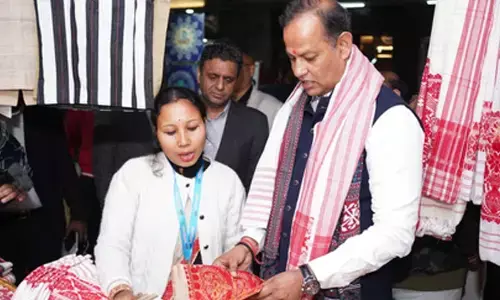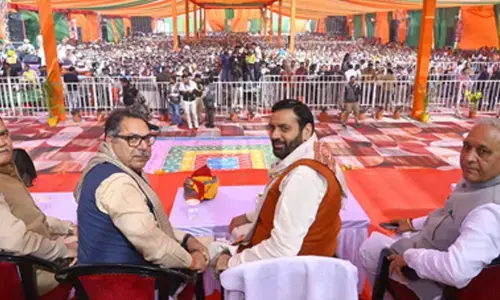Kharamungi: Vestige of feudal past

Krista Kumari is in Class X of a Kannada medium school in Bidar. She studied in Kannada medium till Class IX at ZHPS Kharamungi, her native village.
Nagaligidda (Narayankhed): Krista Kumari is in Class X of a Kannada medium school in Bidar. She studied in Kannada medium till Class IX at ZHPS Kharamungi, her native village.
As there is no Telugu teacher in the school, she does not understand the language. She would probably continue her education in Karnataka itself if her parents do not get her married after Class X.
If she manages to get a degree and chooses to come back to Telangana for employment, she would become a non-local here.
In a way, she is lucky. For, rarely do children complete their 10th class education in Kharamungi as the school operates only till Class IX. After that, most of the children either become labourers or get married at a very early age.
There are at least 50 out-of-school children in the village, according to Chandramma, leader of the women’s Self-Help Group in the village.
In the village, there are 90 children in the primary school and 50 in the high school. There are four permanent and four Vidya volunteers teaching 9 classes in these schools.
There has been no Telugu teacher for years in the schools. Naturally, the children do not know Telugu. Most of the villagers do not speak Telugu.
As the village is located in a remote part of Telangana-Karnataka border, nobody wants to volunteer as teacher there. Three teachers in these schools come all the way from Bidar to teach.
When The Hans India took up the issue with District Education Officer L Chandrakala, she said that upon issue of DSC notification next year, all such problems would be solved.
Gap in education is just the tip of the iceberg. The village has a feudal and violent past, remnants of which can still be seen on the walls of the Gadi (fort) from where feudal landlords once ruled.
According to old men in the village, Kharamungi was one of the Samithis under the Bidar Taluk during the Nizam’s rule and 14 villages used to come under that Samithi. There was also a police camp in the village.
Almost a century later, what one can see there is burjs (watchtowers) in a dilapidated condition and trees growing out of the landlords’ fort walls as if the victims of caste oppression had been resurrected as trees to bring the fort, spread around four acres, to the ground.
People belonging to more than 20 castes are living in the village now. In many of the villages, the habitations are segregated and persons belonging to SCs (Malas and Madigas) live in a different block.
There are Hindus, Muslims, Christians and Buddhists who live harmoniously in the village.There is a beautiful statue of Dr BR Ambedkar installed at the entrance of the village.
The village has seen several movements initiated by human right activists like Bojja Tarakam, who also inaugurated the statue in 1990.
There is also a Buddhist temple in the SC (Mala) community block, where all the 15 mala families offer prayers to Lord Buddha and Dr Ambedkar. Most of the SC (Madiga) community members practice Christianity. A church is being built in the village. In all, 15 Mala families and 70 Madiga families are living together.
People from the SC communities are daily wage earners as most of them are landless. Those who do have lands are the ones who were assigned lands by the government some 40 years ago.
Saranappa (80) owns five acres of such land. The land is located in a rocky, hilly terrain and is uncultivable due to the nature of soil. He has four sons and two daughters.
He cannot afford to clear the rocks and make the land cultivable because he will have to incur heavy expenses.
There are many like him, but for some reason NREGS funds are not being used to carry out works to make their lands cultivable.
Such works can assure more workdays to the weaker sections. As a result, these people work in the farmlands of the so-called upper caste farmers, getting Rs 100 per day as wages.
It is ironic that the Manjeera river flows just two km away from the village, before joining the Singur project. A lift irrigation project was sanctioned to provide an ayacut of 600 acres of land in the village.
However, funds were misused and the project hasn’t seen the light of the day. Even if the project materialises, there is no guarantee that it would irrigate the barren fields of the Dalits.
In the recent floods, 700 acres of farmland was submerged in the village due to Manjeera backwater effect.
The SC Colony resembles a typical Dalit ghetto with no drainage system, no roads or even a crematorium. There is no bus service to the village, due to which people have to depend on autos coming from Karasgutti, which is located 5 km away from Kharamungi.
There are public bore-wells in the Dalit Colony which people use judiciously. Yet, there is no water facility in the primary school. The only computer in the school is used by the principal.
There is not even a single toilet in the Dalit Colony, due to which the villagers have to defecate openly. The situation is not any different in other communities in the village.
It is also believed that some followers of Prophet Mohammed had come and settled in Kharamungi centuries ago.
However, the Muslim population, which stood at 50 per cent during the Nizam era, has now come down to just 5 per cent.
One of the red flags is the issue of 500 acres of Nizam's Inam (gift) land which was given to one Shaik Saidulu who passed away long back. It is not clear who is in position of the land or who owns it currently.
Gadde Kashinath Bassappa, former sarpanch, whose father was thrice the sarpanch of the village, agrees that caste discrimination is still there in the village, though not at a stage where it could take a violent turn or create rivalry amongst the communities.
Kharamungi has gone a long way breaking away from a feudal past when caste discrimination thrived. But like Dr Ambedkar said, if caste discrimination needs to be addressed, class discrimination needs to be addressed. Both cannot be viewed in isolation.
For achieving this, all-round development is needed and the best tool to achieve this is ‘education’, which has been elusive to the people of Kharamungi, irrespective of their caste.
Looking at women in the village, one is reminded of what Dr Ambedkar said: “I measure the progress of a community by the degree of progress which women have achieved.”
















